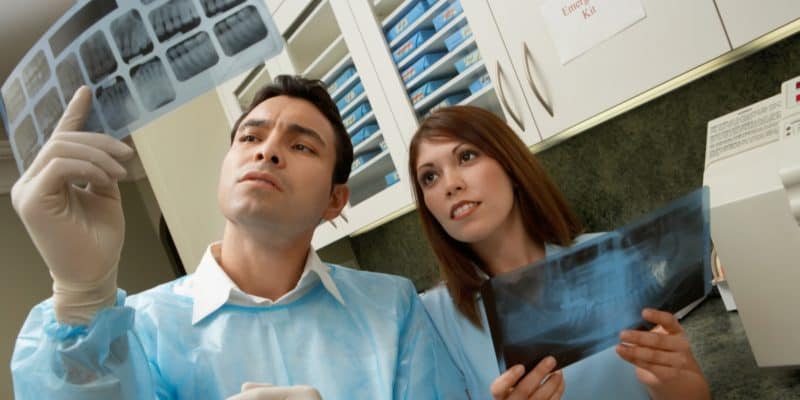


Dentistry, General Dentistry, Tooth Extraction
The 5 Tooth Saving Steps Of Endodontics Treatment
Endodontics is a branch of dentistry that deals with the dental pulp and tissues surrounding the roots of a tooth. In fact, the word etymology comes from the Greek words “endo” meaning inside and “odont” meaning tooth. It is also known as root canal treatment. A dentist who specializes in root canal therapy works as an endodontist.
What is Endodontic treatment?
One of the most common types of endodontic procedures is root canal treatment. It is a procedure that allows an endodontist to access the hollow interior of the tooth also known as the pulp. He needs to remove the inflamed, infected and necrotic nerve and blood vessel tissues. As soon as he thoroughly disinfects the root canal, the endodontist will seal the root tip with a gutta-percha material.
Once the root canal procedure is complete, he fills the hole using materials such as silver, amalgam, composite resin, porcelain or gold. He may also recommend the tooth have a crown after the endodontics, especially if it has many roots. On the other hand, the six front teeth in both dental arches only have single roots and typically do not need any crown.
Why is an endodontic treatment necessary?
The endodontics treatment is common for teeth that have developed an abscess and infection on the pulps. Most of the time, the dentist needs to take a digital X-ray of the mouth to see which tooth needs the treatment. Often, deep tooth decay requires a root canal treatment even if the patient doesn’t feel any pain or sensitivity. However, if a tooth is sensitive to hot temperatures but cold food or drinks relieve it. Then this shows a sign of gas from the bacterial build-up inside it.
Furthermore, the hot temperature heats the gas caused by bacteria contained within the hard shell of the tooth. Also, this may lead to pain and inflammation of the surrounding gums as the tooth structure is unable to expand from the pressure.
What are the steps in the endodontics procedure?
Dental evaluation
All endodontics procedures begin with a preliminary radiograph or dental x-ray imaging. The endodontist will use it to check the size of the tooth and will provide a representation of the roots of the compromised tooth. He also needs to see any obstruction, points of divergence and other potential complexities. Moreover, he may need extra images during and after the endodontics therapy to ensure the success of the treatment.

Isolation of the tooth and cavity access
Your endodontist administers local anesthetic around the treatment area to ease any discomfort. Next, he isolates the tooth from the surrounding gums and cheeks to perform the treatment thoroughly. Then, he accesses the pulp chambers of the tooth.
Removal of the pulp
He expertly removes the infected pulp from the inside of the canals with the help of his instruments.
Cleaning and disinfecting the canals
Additionally, your endodontists use antibacterial agents such as diluted sodium hypochlorite to purify the removed pulp. Another round of cleaning needs to be complete after the disinfection to ensure that the treated tooth is free from any chemicals.
Sealing the root canals
As a final step, the dentist seals the holes of the root canals using a biocompatible resin material called gutta-percha. Sealing them will prevent the entry to food particles and prohibit the growth of bacteria inside the treated tooth.
The endodontics procedures are invasive, so an evaluation of the patient’s health history is necessary. Dentists need the help of sedatives for easy administration of the procedure while the patient is completely relaxed. Sedation is highly advisable for patients with dentophobia and those with low pain tolerance. If you want to know more about the benefits and cost of endodontic treatments, call your local dentist today.
Share This Article
Subscribe to
Our Newsletter
Fill your email below to subscribe
to our newsletter

About DentistryEd
Sharky Liu is the founder and CEO of DentistFind, a results-driven dental marketing platform and marketing service that applies an analytical and data-based approach to increase new patient acquisition for dental practices.
Recent Post
Найдите Лучшие Онлайн Казино На зарубежном Языке Апрель 202
11 Concealed From The Public View Information Of The Video Casino Features Film Threa
How In Order To Start An On The Internet Casino: Costs, Permits, Games And Mor
Follow Us
Recent Post
5 Common Injuries That Need Dental Emergency Care
Periodontal Gum Disease Treatment: Advantages of Laser Therapy
Should You Be Worried About Amalgam Dental Fillings?
Ceramic Braces And Other Ways To Secretly Straighten Teeth
Please Read Disclaimer
Note: This information is for general education purposes only. It is not to be used as a substitute for medical advice from your eye doctor or refractive surgeon.
© 2018 Dental Clinic Images and text on this site belong to DentistFind.Com Copying or reproducing any text or graphics from this website is strictly prohibited by copyright law.